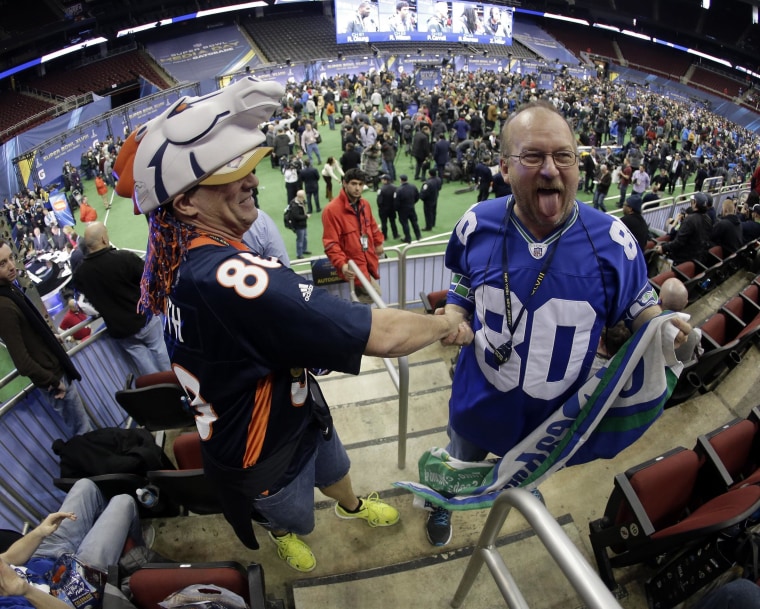Once the Super Bowl is over and the 2013 season fades into memory, live NFL games next year will find themselves battling against an adversary that's more powerful than its ever been: the league's own broadcasts.
Live football is vying against an HDTV and smartphone revolution that threatens its stunning growth and continued pre-eminence in the United States. Ten teams played to stadiums less than 95 percent full on average in 2013, double the number from 2008. Meanwhile, TV ratings were higher than during any season since 2006.
The NFL is not only playing catch-up with the mesmerizing potential of 110-inch, ultra high-definition TVs and the addictive nature of smartphones and handheld tablets. It's also facing stubborn, outdated thinking. As one team executive told CNBC, many older and unsophisticated owners are unwilling to invest in new wireless networks. "The only way some owners can use the Internet is for someone else to switch on a computer," he said, "and to tap the keys for them to get onto the Web."
"Owners just don't understand that wireless networks are as crucial to stadiums as concession stands and bathrooms."
"Owners just don't understand that wireless networks are as crucial to stadiums as concession stands and bathrooms," the official said. "[Commissioner Roger] Goodell gets it. The NFL's CIO gets it. Yet you mention $5 million for Wi-Fi infrastructure investment, and they say 'Why spend that money on the Internet, so teenagers can do illicit things?' If teams don't become more engaging with Wi-Fi and apps, people won't come to games."
NFL Chief Information Officer Michelle McKenna-Doyle said she knows there's a "couchgate" problem. Fans will stay home if the stadium experience isn't "enhanced" to meet the growing challenge of new TV technology. With smartphone usage growing about 20 percent a year, McKenna-Doyle must also convince team owners that mere cellular service is not enough. It must be integrated with advanced Wi-Fi networks to assure limitless wireless access for intensive applications.
"We understand TVs are more immersive," McKenna-Doyle said, "and we need to give fans greater connectivity. We still have an awesome product. It is a tough challenge. A lot of clubs haven't reinvested in networks. But our product can't be duplicated at home, and we will do anything to get people off their sofas."
Jonathan Kraft, president of the New England Patriots and co-chairman of the NFL's Digital Committee, told CNBC that less than a quarter of the 32 teams have new Wi-Fi networks that meet minimum league protocols.
Smart device as a pacifier The league has shown remarkable prowess in attracting TV audiences—regular season games in 2013 averaged 17.6 million viewers, making it the second most-watched season ever. That, in turn, boosted the league's licensing revenue and signing precedent-setting deals with TV networks. The NFL's latest agreement with ESPN alone is worth $15.2 billion over eight years.
Brian Dunphy, Qualcomm's senior director of business development, said the league has not met the Facebook generation's demands for instant connectivity and personalized mobile content.
"There's so much texting, streaming videos, looking at Fantasy Leagues, accessing Netflix, the phone has become a pacifier. Seventy percent of people coming to stadiums have a smart device. The adoption curve of network technology is so incredible, the 'table stakes' for owners is to just meet demand, enhance that connectivity."
"They have to make that commitment—and some are—or they will lose fans. People can sit at home comfortably with all their devices, multitasking in front of a 60-inch HD TV next to their friends and a refrigerator full of beer."
At the Miami Dolphins' Sun Life Stadium, which team vice chairman Matt Higgins calls "an experimental laboratory," Qualcomm last year created a virtual "geo-fence" perimeter. Fans can access information on concession stands, stats, promotions or digital messages through a phone app. Dolphins' attendance has suffered the last three years (its 76.3 percent of capacity rate in 2012 ranked last).
The Patriots under Kraft's leadership have explored Internet "possibilities" since 1994, and were the first NFL club to devise an info-providing team app in 2008.
"Since our fans spend a lot of money to get to Gillette Stadium, we gave them full Wi-Fi three years ago," said Kraft, who partnered with a firm called Goodman Networks in 2010 to install a 2G/3G AT&T distributed antenna system that provided wireless coverage. Kraft said teams need to provide a "high-class, seamless mobile technology. Now we need apps showing the shortest line to bathrooms, pictures and comments of Tom Brady from the team plane and the locker room."
Other teams are adopting the strategy of creating wireless networks with no limits on uploads or downloads. A dramatic example is the San Francisco 49ers' new Santa Clara stadium, where two former Facebook IT execs are designing the network.
Super agent Leigh Steinberg, who was the inspiration for the film "Jerry Maguire" and has represented Troy Aikman, Howie Long, and Ben Roethlisberger, is skeptical about the league's high tech push.
"The only way the league is going to meet the HDTV challenge is to give fans interactive experiences, contests, games, video content that jumps off those Jumbotrons. There are too many boring interludes in stadiums. Americans' attention spans have grown so short, the NFL must provide constant stimulation or else it will soon face a major crisis."
